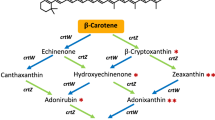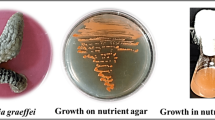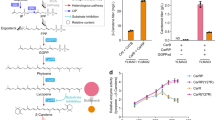Abstract
We performed the chemical mutagenesis of Halobacillus halophilus (the producer of a C30 carotenoid, methyl glucosyl-3,4-dehydro-apo-8′-lycopenoate) to isolate novel carotenoids that are biosynthetic intermediates of methyl glucosyl-3,4-dehydro-apo-8′-lycopenoate. As a result, we isolated two novel C30 carotenoids, hydroxy-3,4-dehydro-apo-8′-lycopene and methyl hydroxy-3,4-dehydro-apo-8′-lycopenoate, which were biosynthesized through a novel 8′-apo C30 pathway. These carotenoids showed antioxidative activity in the 1O2 suppression model.
Similar content being viewed by others
Introduction
Some species of bacteria, yeasts and fungi, as well as algae and higher plants, can synthesize a large number of carotenoids, and some marine bacteria can produce dicyclic, monocyclic or acyclic carotenoids.1, 2 More than 750 carotenoids with different molecular structures have been isolated from natural sources.2 Evaluating the pharmaceutical potential of such various carotenoid pigments could be an exciting field of medical research; however, the carotenoid species so far studied for this purpose have been restricted to a small number, including dicyclic carotenoids such as β-carotene, α-carotene, β-cryptoxanthin, zeaxanthin, lutein, canthaxanthin, astaxanthin and fucoxanthin, and an acyclic carotenoid, lycopene.3, 4, 5, 6 With the exception of those carotenoids that can be isolated from a species of higher plants or be chemically synthesized, it has been difficult to find natural sources that can supply sufficient amounts of these rare carotenoids.
In previous studies, we have performed the analysis of novel or rare types of carotenoids from new colored marine bacteria, which were classified as belonging to a new species by 16S rRNA analysis.7, 8, 9 These studies have reported the isolation of rare carotenoids, (3R)-saproxanthin and myxol, from Flavobacteriaceae,7 and novel glyco-C30 carotenoids (diapolycopenedioic acid xylosyl esters A, B, and C from Rubritalea squalenifaciens8 and methyl glucosyl-3,4-dehydro-apo-8′-lycopenoate from Planococcus maritimus9).
We found that a moderately halophilic bacterium Halobacillus halophilus (formerly called Sporosarcina halophila) produced methyl glucosyl-3,4-dehydro-apo-8′-lycopenoate, which is the same C30 carotenoid recently isolated from P. maritimus.9 Because methyl glucosyl-3,4-dehydro-apo-8′-lycopenoate has a unique structure and antioxidative activity, we searched for its biosynthetic intermediates to investigate the biosynthetic pathway and to find novel antioxidative structures. For this study, we performed chemical mutagenesis with H. halophilus, and obtained mutant OC1, which shows a light orange phenotype (parent strain: deep orange). From OC1, we isolated two novel carotenoids, hydroxy-3,4-dehydro-apo-8′-lycopene and methyl hydroxy-3,4-dehydro-apo-8′-lycopenoate. In this report, we describe the isolation, structural determination and the antioxidative (1O2 suppressive) activity of these compounds.
Results
Culture of the bacteria and isolation of pigments
OC1 was inoculated into 100 ml of the seed medium (Marine Broth 2216; Difco, Becton-Dickinson, Heidelberg, Germany) in a 500 ml Erlenmeyer flask, and cultured at 30 °C for 24 h on a rotary shaker (150 r.p.m.). Two milliliters of the seed culture was inoculated into 100 ml portions of the production medium (=seed medium), and cultivation was carried out at 30 °C for 24 h on a rotary shaker (150 r.p.m.). The OD490 of the culture reached 4.0 at the end of fermentation.
OC1 cells were isolated from 16 l of culture by centrifugation at 13 000 g. After removing the supernatant, we suspended the cells in 1.0 M NaOH at 40 °C for 30 min and sonicated them for 5 min to digest the cell wall. After removing the NaOH solution by centrifugation at 13 000 g, we extracted the orange pigment in the digested cells three times with dichloromethane (CH2Cl2)–MeOH (1:1). The extracts were combined, concentrated to a small volume in vacuo and partitioned between ethyl acetate (EtOAc)/H2O without adjusting pH. The EtOAc layer was evaporated to dryness (307.1 mg) and subjected to silica gel chromatography (Silica Gel 60; KANTO CHEMICAL, Tokyo, Japan) using n-hexane–EtOAc (3:1). In this chromatography, two orange fractions (fraction I and II) were obtained, collected and concentrated to dryness to give an orange oil (fraction I, 5.9 mg) and an orange powder (fraction II, 1.8 mg). The orange oil (fraction I) was washed with n-hexane, and the precipitate was subjected to preparative silica gel HPLC (Senshu Pak SIL column, 10 × 250 mm; Senshu Scientific, Tokyo, Japan) and developed with n-hexane–acetone (7:2) as a solvent (flow rate 3 ml min−1). The light orange component (retention time (Rt) 8.28 min) was collected and concentrated to give pure hydroxy-3,4-dehydro-apo-8′-lycopene (1, 1.5 mg). The orange powder (fraction II) was also washed with n-hexane and the precipitant was subjected to preparative silica gel HPLC (Senshu Pak SIL column, 10 × 250 mm) and developed with n-hexane–acetone (3:1) as a solvent (flow rate 3 ml min−1). The deep orange component (Rt 11.2 min) was collected and concentrated to give pure methyl hydroxy-3,4-dehydro-apo-8′-lycopenoate (2, 0.3 mg).
Structural elucidation
Compound 2 was dissolved in CH2Cl2 and analyzed by positive ion high-resolution electrospray ionization mass spectrometry. The (M+Na)+ peak was observed at m/z 485.30331 (calcd: 485.30316), and the molecular formula of 2 was determined to be C31H42O3.
The 1H NMR spectrum for 2 in CDCl3 showed 8 methyl (Me) singlets, 1 sp3 methylenes and 15 sp2 methines (Table 1), and the 13C NMR spectrum for 2 revealed 8 Me, 1 sp3 methylenes, 15 sp2 methines, 1 sp3 quanternary carbons and 6 sp2 quaternary carbons (Table 1). These spectra were closely similar to that of methyl glucosyl-3,4-dehydro-apo-8′-lycopenoate tetraacetate (Table 1). Although the signals due to glucose in methyl glucosyl-3,4-dehydro-apo-8′-lycopenoate were not observed in 2. Because the molecular formula of 2 was methyl glucosyl-3,4-dehydro-apo-8′-lycopenoate—C6H11O5, it was proposed to be a deglucosyl derivative of methyl glucosyl-3,4-dehydro-apo-8′-lycopenoate. The difference of the 13C chemical shift in C-1 (δC 71.0 in 2 and δC 78.8 in methyl glucosyl-3,4-dehydro-apo-8′-lycopenoate tetraacetate) supported this structure. Thus, the structure of 2 was determined to be methyl 1-hydroxy-3,4-didehydro-1,2-dihydro-apo-8′-lycopenoate (Figure 1). The key 1H-13C long-range couplings, J values and δC values observed in the NMR analyses of 2 are shown in Figure 2.
Compound 1 was dissolved in CH2Cl2 and analyzed by positive-ion high-resolution fast atom bombardment mass spectrometry. The M+ peak was observed at m/z 418.3242 (calcd: 418.3236), and the molecular formula of 1 was determined to be C30H42O.
The 1H NMR spectrum of 1 in CDCl3 showed 8 Me singlets, 1 sp3 methylenes and 15 sp2 methines, and the 13C NMR spectrum of 1 revealed 8 Me, 1 sp3 methylenes, 15 sp2 methines, 1 sp3 quanternary carbons and 5 sp2 quaternary carbons (Table 1). These NMR spectra were quite similar to those of 2, whereas the signals of a carbonyl carbon (C-8′ (δC 169.0)) and methoxy signals (H-21′ (δH 3.77) and C-21′ (δC 51.8)) were not observed in 1, and one singlet Me signal (H-8′ (δH 1.82) and C-8′ (δC 26.3)) was observed only in 1. Considering these observations and the molecular formula of 1 (2— CO2), 1 was proposed to be C-8′ deoxygenated derivative of 2. This was confirmed by the observation of 1H-13C long-range coupling from H-8′ and H-19′ (δH 1.82) to C-9′ (δC 135.8) and C-10′ (δC 126.1) in the heteronuclear multiple bond correlation experiment of 1 (Figure 2). Thus, the structure of 1 was determined to be 1-hydroxy-3,4-didehydro-1,2-dihydro-apo-8′-lycopene (Figure 1). The key 1H-13C long-range couplings, J values and δC values observed in the NMR analyses of 1 are shown in Figure 2.
The IUPAC-IUB semisystematic names of 1 and 2 are 1-hydroxy-3,4-didehydro-1,2-dihydro-8′-apo-ψ-caroten, and methyl 1-hydroxy-3,4-didehydro-1,2-dihydro-8′-apo-ψ-caroten-8′-oate, respectively, which are both novel carotenoids. The physicochemical properties of 1 and 2 are summarized in Table 2.
Antioxidative activity
We examined the 1O2 suppression activity of 1 and 2, and the IC50 values were 79 and 44 μM, respectively. We also examined the 1O2 suppression activities of methyl glucosyl-3,4-dehydro-apo-8′-lycopenoate, astaxanthin and β-carotene. Their IC50 values were 5.1, 8.9 and >100 μM, respectively.
Discussion
In this study, we found two novel carotenoids, hydroxy-3,4-dehydro-apo-8′-lycopene (1) and methyl hydroxy-3,4-dehydro-apo-8′-lycopenoate (2) in a pigment mutant OC1 that was obtained by mutagenesis of H. halophilus. The parent strain, the carotenoid gene cluster of which was recently elucidated,10 produces methyl glucosyl-3,4-dehydro-apo-8′-lycopenoate, whereas both 1 and 2 were deglucosylated carotenoids; therefore, OC1 should have a mutation in a gene encoding a glucosylase, which is responsible for the glucosylation of 1. The prominent candidate gene for glucosidation is orf-AT in the carotenogenic gene cluster of H. halophilus.10 Because 1 was the major carotenoid in OC1, it determines its light orange color.
It should be pointed out that the identified intermediates 1 and 2 as well as methyl glucosyl-3,4-dehydro-apo-8′-lycopenoate are 8′-apo derivatives with asymmetrical arrangement of the Me groups (Figure 3), unlike the 4,4′-diapo derivatives, which are typically synthesized with two molecules of farnesyl diphosphate.10, 11 In addition, the identification of intermediate 1 without terminal end-group oxidation excludes the possibility that apo-8′ products are derived by cleavage of C40 carotenoids at position 8′. Therefore, we propose that the C30 pathway in H. halophilus initially starts with apo-8′ phytoene by condensation of C20 geranylgeranyl pyrophosphate (GGPP) with C10 geranyl pyrophosphate (GPP). This postulated novel apo-8′ C30 biosynthetic pathway is outlined in Figure 3.
In the later biosynthesis steps toward methyl glucosyl-3,4-dehydro-apo-8′-lycopenoate, glucosylated 1 seems to be oxidized to the corresponding aldehyde in the terminal Me group with CrtNb-like enzyme, as described by Tao et al,11 and then oxidized to the corresponding carboxylic acid with another oxidase, which may be encoded by gene CrtNc.10 Due to the ratio of about 5:1 between 1 and 2, it can be assumed that in the parent strain, compound 1 is the preferred substrate for the glucosylase and that terminal oxidation to a carboxylic group typically proceeds with glucosyl-3,4-dehydro-apo-8′-lycopene as the original substrate for the CrtNb-like enzyme (Figure 3).
Both 1 and 2 possessed 1O2 suppression (antioxidative) activity (IC50 79 and 44 μM, respectively), but their activities were not so potent as methyl glucosyl-3,4-dehydro-apo-8′-lycopenoate (IC50 5.1 μM). This may be explained by the lower hydrophobicity of 1 and 2, as reported by Shimidzu et al.12 Shimidzu et al.12 also reported that the increasing number of C=C or C=O double bonds conjugated enhanced 1O2 suppression activity. Compound 2 may possess more potent 1O2 suppression activity than 1 for this reason. Further examinations of the antioxidative activities of these carotenoids are in progress.
Experimental section
Taxonomy of the strain
H. halophilus is a moderately halophilic bacterium. Taxonomic analysis of this bacterium was reported previously.13 For our studies, we used the type strain DSM 2266 from Deutsche Sammlung von Mikroorganismen und Zellkulturen GmbH.
Random mutagenesis
Mutagenesis of H. halophilus was carried out with cells resuspended in minimal G10 medium (glucose 10 g, NH4Cl 2 g, FeSO4·7H2O 10 mg, Tris base 12 g, K2HPO4 0.49 g, yeast extract 0.1 g, DSM 141 vitamin solution 1 ml and DSM 79 artificial seawater 250 ml in 750 ml tap water) in the presence of 1.0 M NaCl. To 2 ml of the cell suspension, we added and mixed 20 μl ethyl methane sulfonate (Sigma-Aldrich, Steinheim, Germany) vigorously. After 20 min of incubation at 30 °C, we washed cells twice in G10 medium, diluted 50-fold and grew them in broth (Marine Broth 2216; Difco) overnight. Different dilutions were plated on nonselective agar plates. Colonies were visually screened for white and yellow/orange pigmentation differing from the deep orange color of the parent strain. For further study, we selected a light orange colony named OC1.
Spectroscopic analysis
The 1H and 13C NMR spectra were measured at 400 MHz with a Bruker AMX400 (Bruker BioSpin, Rheinstetten, Germany). High-resolution electrospray ionization mass spectrometry and high-resolution fast atom bombardment mass spectrometry were recorded with a JEOL JMS-T100LP and a JEOL JMS-HX100A mass spectrometer (JEOL, Tokyo, Japan), respectively. UV spectrum was recorded with a Hitachi U-3200 spectrophotometer (Hitachi, Tokyo, Japan).
1O2 suppression experiment
1O2 quenching activity was examined by measuring methylene blue-sensitized photooxidation of linoleic acid.14 Forty microliters of 0.05 mM methylene blue, 10 μl of 2.4 M linoleic acid with or without 40 μl carotenoid (final concentration 1–100 μM, each dissolved in EtOH) were added to micro-glass vials (5.0 ml). The vials were tightly closed with a screw cap and a septum, and the mixtures were illuminated at 7000 lux at 22 °C for 3 h in corrugated cardboard. Then, 50 μl of the reaction mixture was removed and diluted to 1.5 ml with EtOH, and absorbance at 235 nm was measured to estimate the formation of conjugates dienes.15 The value in the absence of carotenoid was determined and 1O2 repression activity was calculated relative to this reference value. Activity is indicated as the IC50 value representing the concentration at which 50% inhibition was observed.
References
Goodwin, T. W. The Biochemistry of the carotenoids in Plant 2nd edn, Vol. 1, 291–319 (Chapman and Hall: London, 1980).
Britton, G., Liaan-Jensen, S. & Pfander, H. Carotenoid Handbook (Birkhauser Verlag, Basel, 2004).
Nishino, H. et al. Cancer prevention by natural carotenoids. Biofactors 13, 89–94 (2000).
Iwamoto, T. et al. Inhibition of low-density lipoprotein oxidation by astaxanthin. J. Atherosclero. Throm. 7, 216–222 (2000).
Naito, Y. et al. Prevention of diabetic nephropathy by treatment with astaxanthin in diabetic db/db mice. Biofactors 20, 49–59 (2004).
Hosokawa, M. et al. Fucoxanthin induces apoptosis and enhances the antiproliferative effect of the PPAR gamma ligand, troglitazone, on colon cancer cells. Biochim. Biophys. Acta 1675, 113–119 (2004).
Shindo, K. et al. Rare carotenoid, (3R)-saproxanthin and (3R,2′S)-myxol, isolated from novel marine bacteria (Flavobacteriaceae) and their antioxidative activities. Appl. Microbiol. Biotechnol. 74, 1350–1357 (2007).
Shindo, K. et al. Diapolycopenedioic acid xylosyl esters A, B, and C, novel glycol-C30-carotenoic acids produced by a new marine bacterium Rubritalea squalenifaciens. J. Antibiot. 61, 185–191 (2008).
Shindo, K. et al. Methyl glucosyl-3,4-dehydro-apo-8′-lycopenoate, a novel antioxidative glyco-C30-carotenoic acid produced by a marine bacterium Planococcus maritimus. J. Antibiot. 61, 729–735 (2008).
Köcher, S., Breitenbach, J., Müller, V. & Sandmann, G. Structure, function and biosynthesis of carotenoids in the moderately halophilic bacterium Halobacillus halophilus. Arch. Microbiol. 191, 95–104 (2009).
Tao, L., Schenzle, A., Odom, J. M. & Cheng, Q. Novel carotenoid oxidase involved in biosynthesis of 4,4′-diapolycopene dialdehyde. Appl. Environ. Microbiol. 71, 3294–3301 (2005).
Shimidzu, N., Goto, M. & Miki, W. Carotenoids as singlet oxygen quenchers in marine organisms. Fish. Sci. 62, 134–137 (1996).
Claus, D., Fahmy, F., Rolf, H. F. & Tosunoglu, N. Sporosarcina halophila sp. nov., an obligate slightly halophilic bacterium from salt marsh soils. Syst. Appl. Microbiol. 4, 496–506 (1983).
Kobayashi, M. & Sakamoto, Y. Singlet oxygen quenching ability of astaxanthin esters from the green alga Haematococcus pluvialis. Biotechol. Left. 21, 265–269 (1999).
Hirayama, O., Nakamura, K., Hamada, S. & Kobayashi, Y. Singlet oxygen quenching ability of naturally occurring carotenoids. Lipids 29, 149–150 (1994).
Acknowledgements
We thank Dr Takashi Maoka (Research Institute for Production Development) for the measurement of HRFAB-MS. We also thank Professor Norihiko Misawa (Ishikawa Prefectural University) for helpful suggestions on the biosynthetic pathway of carotenoids. This work was supported by Grant FP7-KBBE-2007-207948 from the European Commission to G Sandmann and the German Science Foundation (DFG) to V Müller.
Author information
Authors and Affiliations
Corresponding author
Rights and permissions
About this article
Cite this article
Osawa, A., Ishii, Y., Sasamura, N. et al. Hydroxy-3,4-dehydro-apo-8′-lycopene and methyl hydroxy-3,4-dehydro-apo-8′-lycopenoate, novel C30 carotenoids produced by a mutant of marine bacterium Halobacillus halophilus. J Antibiot 63, 291–295 (2010). https://doi.org/10.1038/ja.2010.33
Received:
Revised:
Accepted:
Published:
Issue Date:
DOI: https://doi.org/10.1038/ja.2010.33
Keywords
This article is cited by
-
Structure and biosynthesis of carotenoids produced by a novel Planococcus sp. isolated from South Africa
Microbial Cell Factories (2022)
-
Heterologous production of novel and rare C30-carotenoids using Planococcus carotenoid biosynthesis genes
Microbial Cell Factories (2021)
-
The biosynthetic pathway to a novel derivative of 4,4′-diapolycopene-4,4′-oate in a red strain of Sporosarcina aquimarina
Archives of Microbiology (2012)






